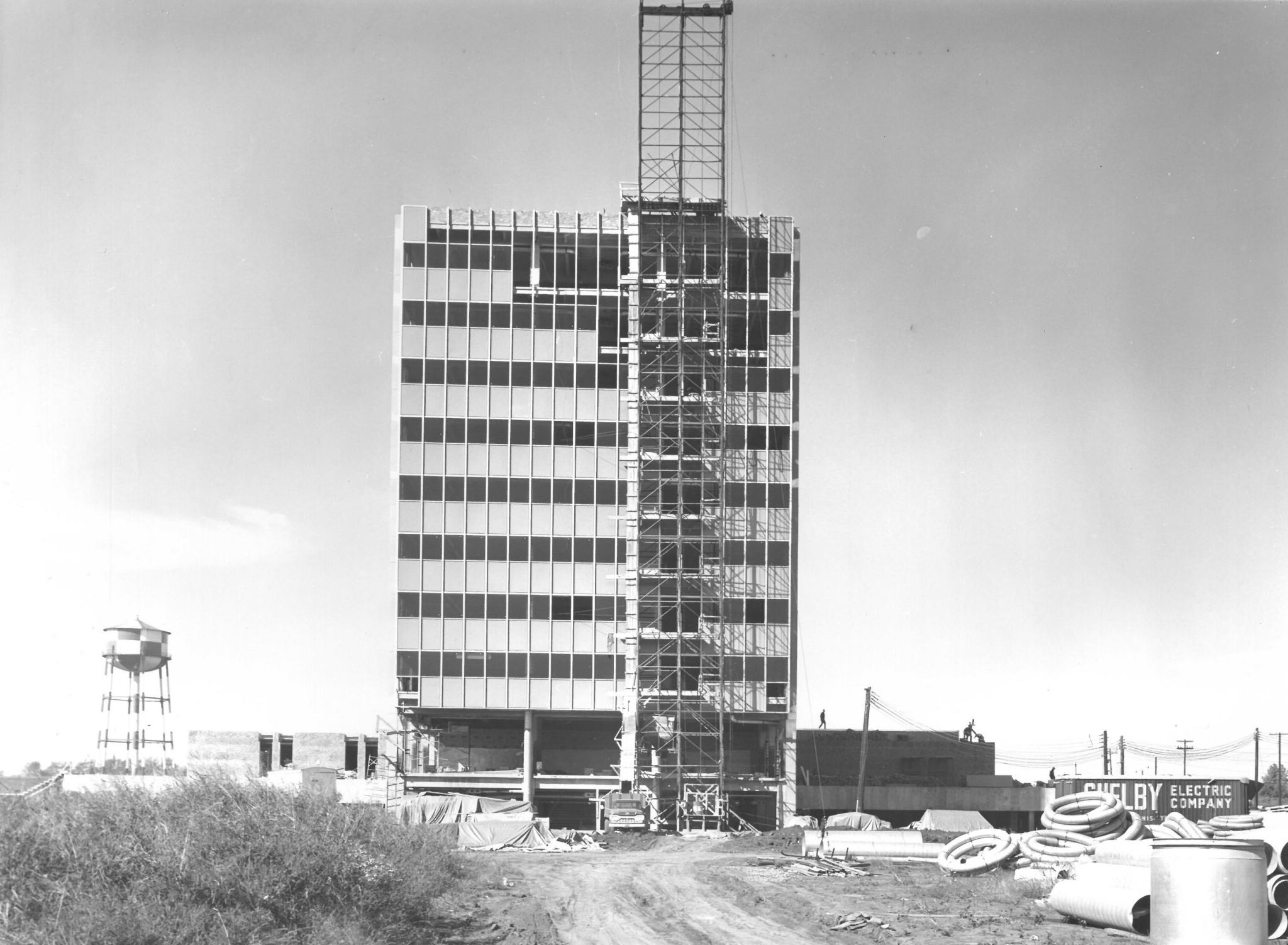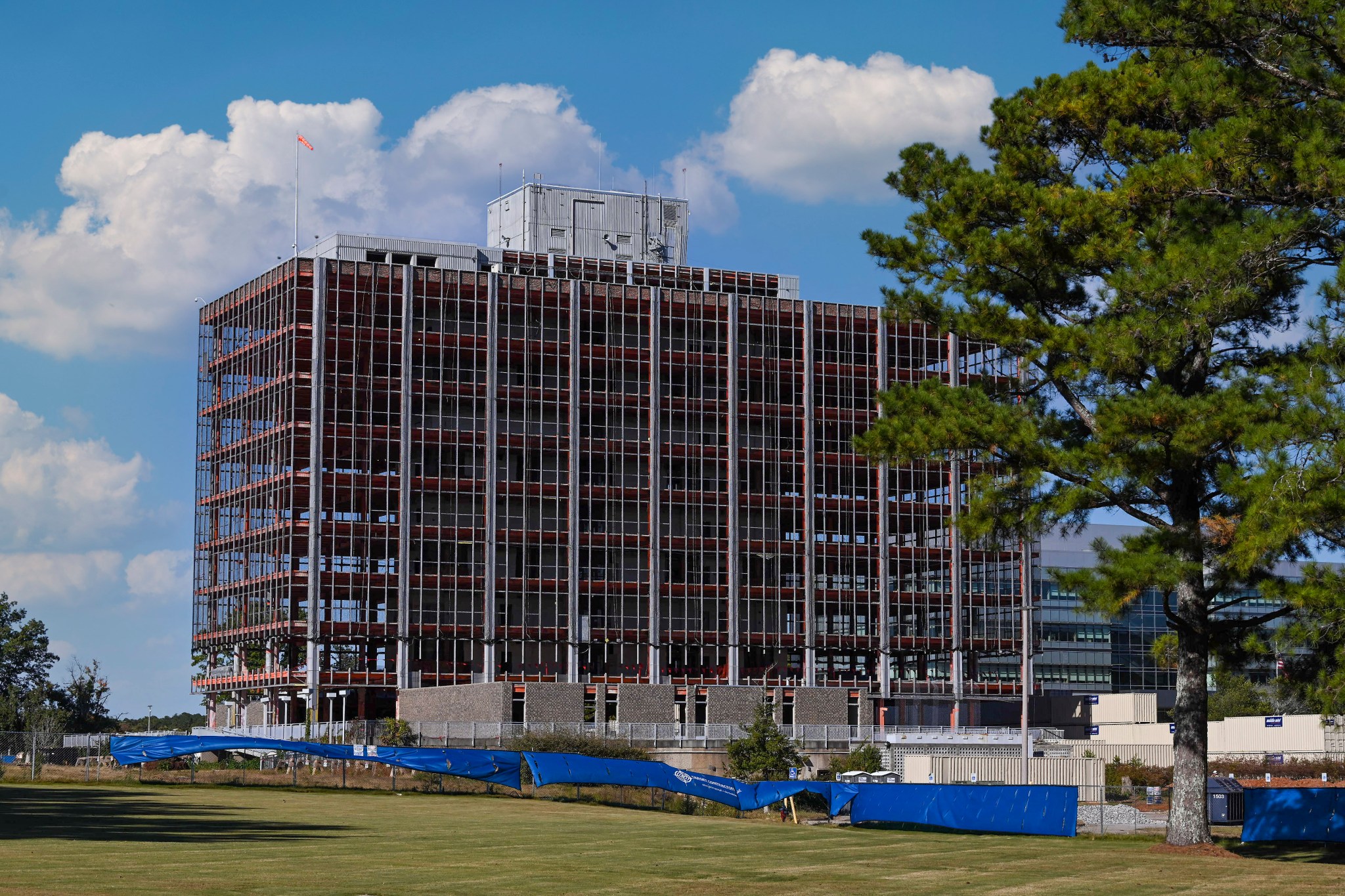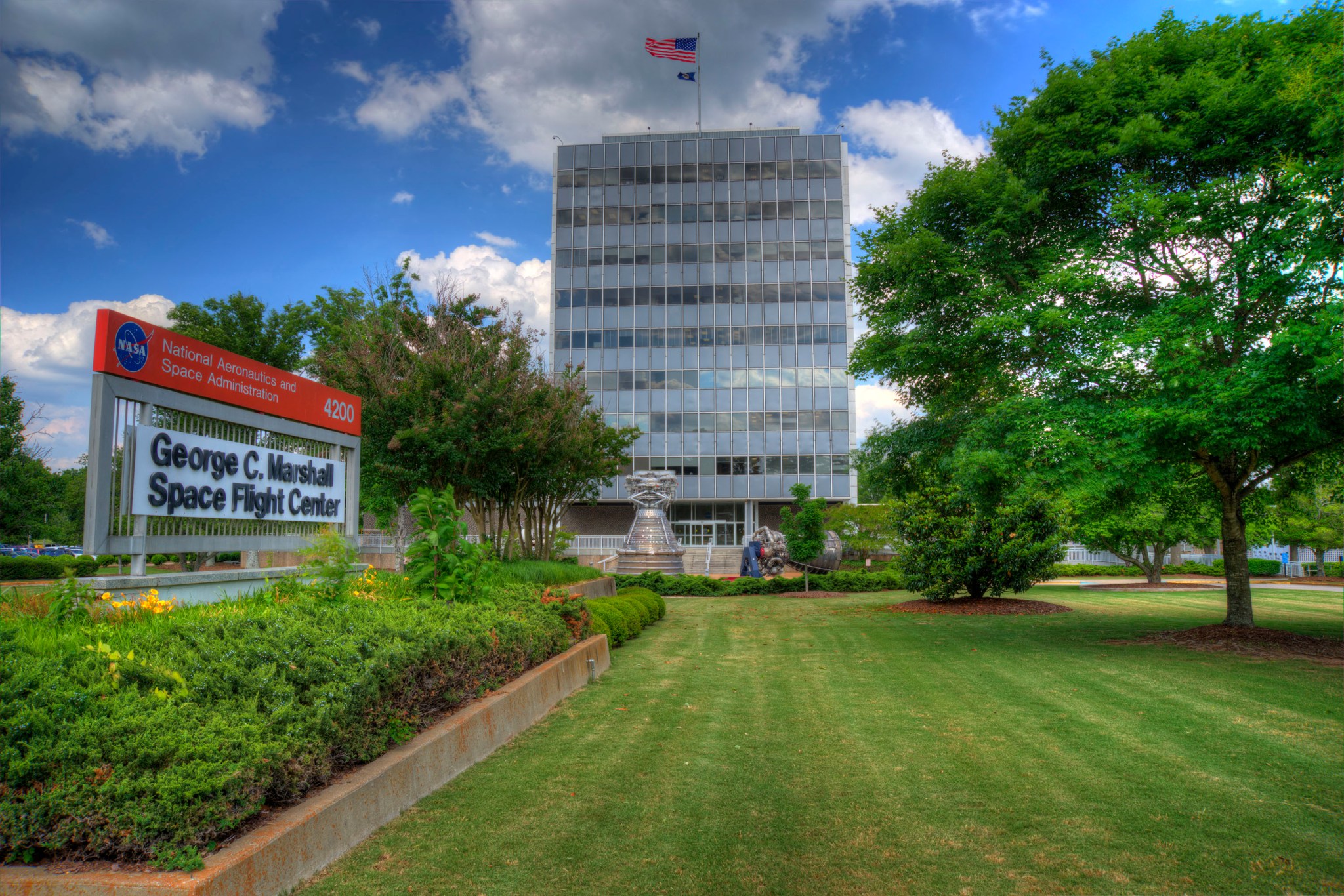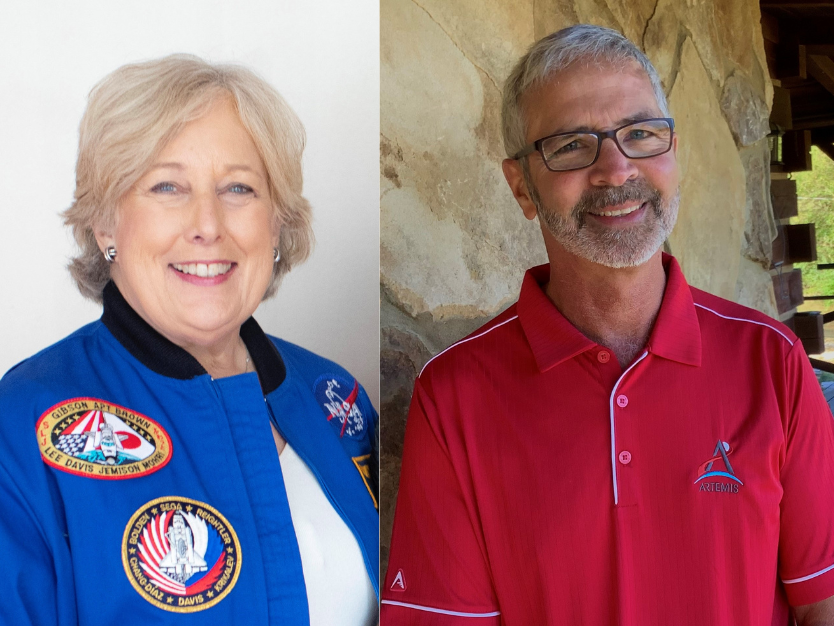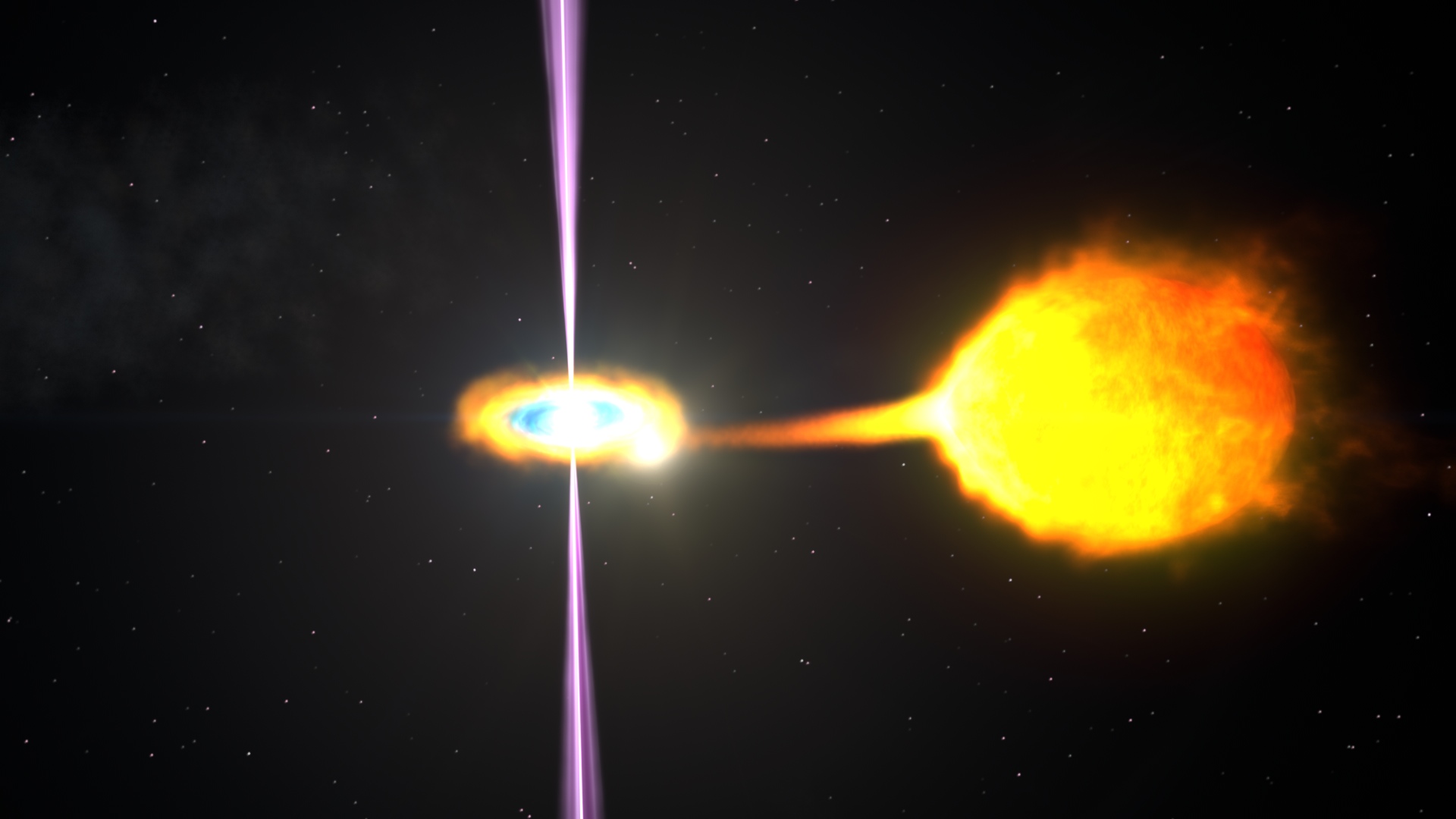In This Week’s Star
- Goodbye, 4200; Marshall Ready to Demolish ‘Site of So Much History’
- NASA Marshall to Livestream Demolition of Historic Building 4200
- ‘Passion and Persistence’ are Keys to Success for Marshall’s Victoria Garcia
- Former Astronaut Dr. Jan Davis Discusses Lessons Workforce Should Learn from Columbia, Challenger; Tony Andreoni receives Golden Eagle Award
- Take 5 with Danny Harris
- Combined Federal Campaign Kicks Off with Charity Fair
- Marshall Hosts Payload Operations Integration Working Group to Discuss Space Station Science
- How Did NASA Test the Artemis Moon Rocket for Launch?
- Marshall Data Scientist Aaron Kaulfus Streamlines Data Discovery
- NASA’s Webb Takes Star-Filled Portrait of Pillars of Creation
- Powerful Neutron Star’s Behavior Surprises IXPE Researchers
Goodbye, 4200; Marshall Ready to Demolish ‘Site of So Much History’
By Rick Smith
Even as NASA and its partners nationwide count down to the launch of Artemis I, opening a bold new chapter in human space exploration, workers at NASA’s Marshall Space Flight Center – which led development and ground testing of the new Space Launch System rocket – are gearing up for a second big countdown.
When the clock reaches zero this time, however, it will mark the Oct. 29 implosion of Building 4200, Marshall’s administrative headquarters for 63 years. That event will close a big chapter of the pivotal NASA center’s history, clearing the way for new missions that will take us deep into the century ahead – and even deeper into the cosmos.
“This is the site of so much history for NASA,” said Marshall Director Jody Singer, its 14th leader since it was founded. “But as responsible stewards of taxpayer dollars, it’s our duty never to linger over yesterday’s successes. Time marches forward, and our space mission awaits. We’re excited to look ahead to the facilities and resources we need to chart the next 60 years and beyond.”
For more than six decades, NASA and the nation have relied on Marshall to deliver its most vital propulsion systems and hardware, flagship launch vehicles, world-class space systems, state-of-the-art engineering technologies and cutting-edge science and research payloads – work overseen by Marshall leaders and managers in Building 4200.
That includes development of the Saturn V rocket that lofted the Apollo missions to the Moon; engines and propulsion hardware for the Space Shuttle Program; hardware, air and water recycling systems, and science communications for the International Space Station; delivery of the Chandra X-ray Observatory and elements of the James Webb Space Telescope; and management of the Space Launch System, the Human Landing System Program, and other elements of NASA’s Artemis-era return to the Moon.
Scott Worley, Marshall’s historical preservation officer, said the real key to NASA’s successful pursuit of its mission over the past six decades isn’t in a building, but in its workforce.
“Buildings come down, but rockets keep going up,” Worley said. “Our work lies beyond the sky.”
Even so, the legacy of Building 4200 lingers in the minds of its former occupants and NASA retirees. Brian Odom, acting NASA chief historian, credits that to the galvanic shift Marshall helped lead over the years.
“It’s not a laboratory or a test site, it didn’t house critical rocket hardware or science payloads,” Odom said. “Its impact is really about the decisions made there, the critical choices enacted across the whole history of American spaceflight. The calls made by those teams still drive us onward, and still color our perception of the best we can be and the finest work we can do.”
Following formal establishment of Marshall in July 1960, Marshall leaders selected architectural firm Wyatt C. Hendrick of Fort Worth, Texas, to design the center’s first administrative hub. Electronic and Missile Facilities Inc. of Valley Stream, New York, built the facility. Ground was broken on Sept. 30, 1961, and the first center employees began moving in June 1963.
Modeled after the utility-meets-expediency formula adopted by U.S. military posts, Building 4200 also was home for years to a library, mail office, photo lab, and other services. Guests who came to meet with Marshall leaders – and often to address team members in spacious Morris Auditorium – routinely included astronauts, White House and congressional representatives, and state executives from all over the world.
But demolishing the aging structure, which would be prohibitively expensive to renovate, opens a path to the future for Marshall and its workforce, said John Green, Marshall’s master facilities planner in the Office of Center Operations.
“The key to success is to evolve and grow to meet the needs of new generations of innovators and engineers,” Green said. “It’s our job to prepare Marshall to tackle new agency directives and to succeed in a changing work environment. We will continue to build facilities as flexible and adaptable as the teams housed in them.”
And those teams will confidently continue to lead NASA and the nation into a rewarding and productive spacefaring future.
Smith, a Manufacturing Technical Solutions employee, supports Marshall’s Office of Strategic Analysis & Communications.
NASA Marshall to Livestream Demolition of Historic Building 4200
By Rick Smith
Members of the public and team members of NASA’s Marshall Space Flight Center are invited to watch live online as a historic chapter comes to a close for the center with the demolition by implosion Oct. 29 of Building 4200, Marshall’s administrative complex for more than six decades.
The event, set for 7:30 a.m., will be livestreamed on Marshall’s YouTube channel and Facebook presence. The feed is expected to go live approximately 30 minutes before the scheduled detonation.
It’s a poignant farewell to a Marshall landmark, said Marshall Director Jody Singer, but as the center continues to serve NASA’s ambitious mission to deliver Artemis crews to the Moon and enable human exploration of Mars, she said the eyes of the team remain fixed on the future.
The entire Building 4200 complex and surrounding roads remain closed to all Marshall personnel through Oct. 31. No onsite parking is available and all door badge readers are disabled in buildings 4203, 4220, and 4221. Security personnel will divert Redstone Arsenal traffic to alternate roads.
The demolition work is being completed by Target Contractors of Ladson, South Carolina, which this week cleared the 4200 complex to rig explosive charges and conduct thorough site safety testing and inspection. The project is executed through the U.S. Army Corps of Engineers Facilities Reduction Program.
If inclement weather develops, the demolition and livestream will be rescheduled for Sunday morning, Oct. 30. Team members in buildings 4203, 4220, and 4221 may return to on-site work Tuesday, Nov. 1.
Building 4200 is the latest Marshall facility to undergo demolition, owing to its age and the costly upkeep of its outdated electrical system, plumbing, and other utilities. It was the site of early development of rockets powerful enough to loft Apollo crews to the Moon and has remained a world-class resource for NASA propulsion systems, space hardware, and scientific endeavors ever since. Read more about Building 4200 here.
Smith, a Manufacturing Technical Solutions employee, supports Marshall’s Office of Strategic Analysis & Communications.
‘Passion and Persistence’ are Keys to Success for Marshall’s Victoria Garcia
By Rick Smith
Victoria Garcia is a launch vehicle systems engineer and systems integration team lead at NASA’s Marshall Space Flight Center, developing and testing a variety of advanced spacecraft hardware, payloads, and propulsion technologies in support of next-generation human space exploration.
Garcia is also profoundly deaf, a condition she has lived with since birth. “Being deaf is part of who I am,” she said, “but it doesn’t determine how I live.”
On December 14, she’ll prove that it also can’t limit how high she can fly.
Garcia is one of 16 international scientists, engineers, and researchers – all living with disabilities – who will assemble in Houston, Texas, to fly on AstroAccess 2. Much like NASA’s “Vomit Comet,” used to introduce astronaut trainees and others to the effects of microgravity, the AstroAccess program employs a fixed-wing aircraft capable of rapid periods of ascent and descent, simulating the near-weightlessness of low Earth orbit. Participants acclimate themselves, conduct science experiments, and take part in video recordings to document the experience and inspire others.
Garcia, who routinely visits classrooms in North Alabama to talk about her work and answer students’ questions about NASA careers, said she’s excited to take part in the flight program – and hopes it will inspire new generations of kids with disabilities to pursue careers in science, technology, engineering, and math.
“It’s a real opportunity to nurture that passion, to invigorate the spirit of discovery and exploration in young people,” she said. “It takes very specific training to safely live and work in space, but there should be no limitations regarding who can pursue that work.”
Garcia said the advancement of new technologies that enable equal access for people with disabilities also can help remove systemic obstacles to their pursuit of careers at NASA – even as astronauts.
“I wouldn’t be surprised, as we refine assistive technologies and shatter old prejudices, if ten years from now we deliver a set of mission parameters that could be undertaken by flight crews including one or more members with disabilities,” she said.
In keeping with President Biden’s goal to increase diversity, equity, inclusion, and accessibility across federal government workplaces, Marshall strives to recognize, promote, and celebrate the contributions of its workers with disabilities and sustain inclusive employment policies and practices. National Disability Employment Awareness Month, observed each October, is a vital reminder of the value of that effort.
Is she nervous about her upcoming flight, an experience completely new to her? Sure, Garcia said – but progress means stepping outside one’s comfort zone.
“If people with disabilities are denied opportunities, that’s just a failure of imagination on the part of those around us,” she said. “It’s all about passion and persistence. There will always be barriers in society until we challenge and change them. The real trick is not to put up additional mental barriers of our own, denying opportunities to ourselves and others.”
Garcia, who was born and raised in Miami, Florida, earned an undergraduate degree in mechanical engineering in 2005 from Rensselaer Polytechnic Institute in Troy, New York, and received her master’s degree in mechanical engineering in 2008 from the Georgia Institute of Technology in Atlanta. She is a 2018 graduate of Marshall’s System Engineering Leadership Development Program and is 2013 recipient of the NASA Early Career Achievement Medal.
Inspired by an internship at NASA’s Kennedy Space Center following her undergraduate studies – during which she led a team tasked with installing water and ammonia filters on hardware bound for the International Space Station – Garcia joined NASA in 2008.
For the last eight years, she’s been part of the Space Launch System team at Marshall. Now, with the launch of Artemis I pending, she’s already looking ahead to what’s next: development of the Human Landing System to ferry astronauts to and from the Moon’s surface, for example, and the Mars Ascent Vehicle that will enable Martian rovers to return the first soil and rock samples from the Red Planet. Marshall leads both efforts.
“It’s exciting to see so many high-priority projects in development, especially as complex and rewarding as these will prove to be,” she said. She also welcomes increased commercial and international partnerships, a necessary paradigm shift to effectively pursue the full range of NASA’s science and exploration goals.
“I see NASA as a catalyst, building the future, exploring the frontier,” she said. “The Moon is just the next stop, a staging area as we expand our reach into the cosmos – and the more of humanity we can include in that endeavor, the better.”
Smith, a Manufacturing Technical Solutions employee, supports Marshall’s Office of Strategic Analysis & Communications.
Former Astronaut Dr. Jan Davis Discusses Lessons Workforce Should Learn from Columbia, Challenger; Tony Andreoni receives Golden Eagle Award
Former astronaut Dr. Jan Davis was the speaker for the Mission Success is in Our Hands virtual Shared Experience Forum on Oct. 20. She reviewed the technical causes for the Columbia and Challenger space shuttle accidents and discussed what can be done – both at organizational and personal levels – to prevent another accident from occurring.
“We’re about to launch Artemis, which is going to be marvelous,” Davis told team members of NASA’s Marshall Space Flight Center. “So, we need to absolutely make sure for these next missions, whether it’s Artemis or something else that you’re working on, that it’s successful.”
Following the Challenger accident in 1986, Davis led the team that redesigned the shuttle’s solid rocket booster external attach ring. She was selected to be an astronaut in 1987 and was a member of the STS-47 (1992), STS-60 (1994), and STS-85 (1997) shuttle missions.
Davis has numerous ties to Marshall. She began her NASA career at the center in 1979 as an aerospace engineer and supported work with the Hubble Space Telescope and Chandra X-ray Observatory. Following her time as an astronaut, Davis was director of the Flight Projects Directorate at Marshall, and she was director of the center’s Safety and Mission Assurance Directorate leading up to shuttle’s Return to Flight in 2005 following the Columbia accident in 2003.
The PowerPoint slides from Davis’ presentation are available here.
Davis is currently a senior technical fellow with Bastion Technologies in Huntsville.
Prior to the presentation, Tony Andreoni, a senior quality engineer with Bastion, received the Golden Eagle Award. He was honored for helping identify an issue ahead of rollout for the first Artemis I launch attempt – the 131st mission that he has supported.
Since 2015, the Golden Eagle Award has been presented quarterly by Marshall’s Mission Success is in Our Hands organization, a safety initiative collaboration between Marshall and Jacobs. The award promotes awareness and appreciation for flight safety, as demonstrated through the connections between employees’ everyday work, the success of NASA and Marshall’s missions, and the safety of NASA astronauts. The award recognizes individuals who have made significant contributions to flight safety and mission assurance. Management or peers can nominate any team member for the award here.
Take 5 with Danny Harris
From his earliest years, Danny Harris was an engineer at heart. Harris, manager of the Habitation Systems Development Office at NASA’s Marshall Space Flight Center, grew up on a small dairy farm outside of Sparta in eastern middle Tennessee, where he quickly learned ingenuity.
“For the most part, you had to build it, make it, fix it, or figure it out yourself to get the work done,” he said. “I was sort of instilled with an inherent comfort and curiosity for all things mechanical.”
That foundation of curiosity, coupled with the work ethic demonstrated by his parents and living within 45 minutes of his future alma mater, Tennessee Technological University in Cookeville, allowed him to imagine a path to work his way through college and obtain a degree in mechanical engineering.
Question: What are your primary responsibilities as manager of the Habitation Systems Development Office?
Harris: I lead a team that oversees a portfolio of activities to develop and advance exploration habitation systems. The office has two major focus areas: Gateway Program support and leadership of the Exploration Systems Development Mission Directorate future habitation concept development for Artemis and Mars.
For Gateway, we provide leadership in vehicle systems integration, vehicle equipment, and launch package management. We’re also the integrators of all of the Gateway support across Marshall including cross program integration, payload operations, research and utilization, and leadership support to Gateway environmental control and life support systems as well as other subject matter expert support. We work to ensure that the Gateway Program’s needs continue to be met with the highest standards possible and are always looking for new ways to grow and expand Marshall’s support to the program.
The other major thrust for our office is leading the Habitation Concept/Pre-Formulation Team for the directorate’s Technical Integration Office. We lead the concept development for future Artemis and Mars habitation systems including in-space and surface habitats, such as the Mars Transit Habitat and Artemis Lunar Surface Habitat. As a part of that work, we are responsible for industry engagement for the advancement of habitation concepts, which includes management of the Next Space Technologies for Exploration Partnerships (NextSTEP) Habitation Systems, a program which uses public-private partnerships to enable commercial development of deep space exploration habitats. We are also responsible for leading engagement with potential international partners for habitation contributions and collaborations.
Question: What excites you most about the future of human space exploration and your team’s role it?
Harris: That we are returning to the Moon and moving human space exploration back beyond low-Earth orbit to stay. Our team is leading NASA’s development of the habitats that will allow that sustained presence on the lunar surface and onward to Mars. We are leading a cross-center effort, leading engagement with U.S. industry and leading international partner collaborations to make it happen. Equally exciting is the fact that habitation systems are seen as a major growth area for Marshall. Knowing that center leadership is behind us and demonstrating that commitment daily is extremely motivational to the team.
Question: What drives/motivates you?
Harris: I’ve been extremely fortunate in 30-plus years in the aerospace business – I spent over a decade in private industry before coming to NASA – to have seen many projects through to full fruition – successfully assembled, tested, launched, and operated in space. A large portion of those 30-plus years has revolved around human spaceflight and mostly habitation systems. When I was asked four years ago to join the then-still in formulation Habitation Systems Development Office to be the Gateway U.S. Habitat Module manager, I could imagine that project being the major capstone to my NASA career. When the U.S. habitat eventually fell out of the Gateway architecture due to overarching agency budget challenges, I struggled for a bit to find a way forward. Ultimately, we pivoted that experience and our team’s strengths to leading the agency’s future exploration habitation developments. Though I won’t be the person that oversees that large habitat project though to launch and operation, be it a lunar surface hab or Mars transit hab, I have come to understand that building and growing our office’s future leaders, who will do exactly that one day, is a far greater achievement.
Question: When was the proudest moment of your career and why?
Harris: There have been many things in my career to be proud of and many to reflect upon and learn from. I’m hopeful that the proudest may be yet to come. But perhaps the proudest moments so far have been those times when adversity was overcome by the team and diverse stakeholders were brought together in unexpected ways to enable mission success. The Lunar CRater Observation and Sensing Satellite (LCROSS) and Lunar Atmosphere and Dust Environment Explorer (LADEE) missions, both for which I was program mission manager, are good examples.
Question: What advice do you have for employees early in their NASA career or those in new leadership roles?
Harris: I’ve grown to realize that there are many effective leadership styles. There is no one-size-fits-all cookbook for leadership. Each individual has to find what is true to them. For me, the key seems to be to embrace authenticity and lean into being as open and transparent as possible with your team. Communicate as clearly, frequently, and genuinely as you can. The more the team can really understand the big-picture vision and the “why” behind the work, the better equipped they are to lead their own way to making the right decisions and setting their own priorities to achieve the overarching organizational objectives.
Combined Federal Campaign Kicks Off with Charity Fair
Attendees at the Food Truck Corral at Redstone Arsenal listen as Marshall Space Flight Center Director Jody Singer speaks during Marshall’s Combined Federal Campaign (CFC) kickoff and charity fair Oct. 25. Several charities participated in the event. Overseen by the Office of Personnel Management, CFC is the official workplace giving campaign for federal employees and retirees. The campaign supports charitable and nonprofit organizations at the local, regional, and national levels. CFC celebrated its 60th anniversary last year. Since its inception, the CFC has raised more than $8.6 billion for charities and people in need. The 2022 campaign continues through Jan. 14, 2023. Learn more here. (NASA/Alex Russell)
Marshall Hosts Payload Operations Integration Working Group to Discuss Space Station Science
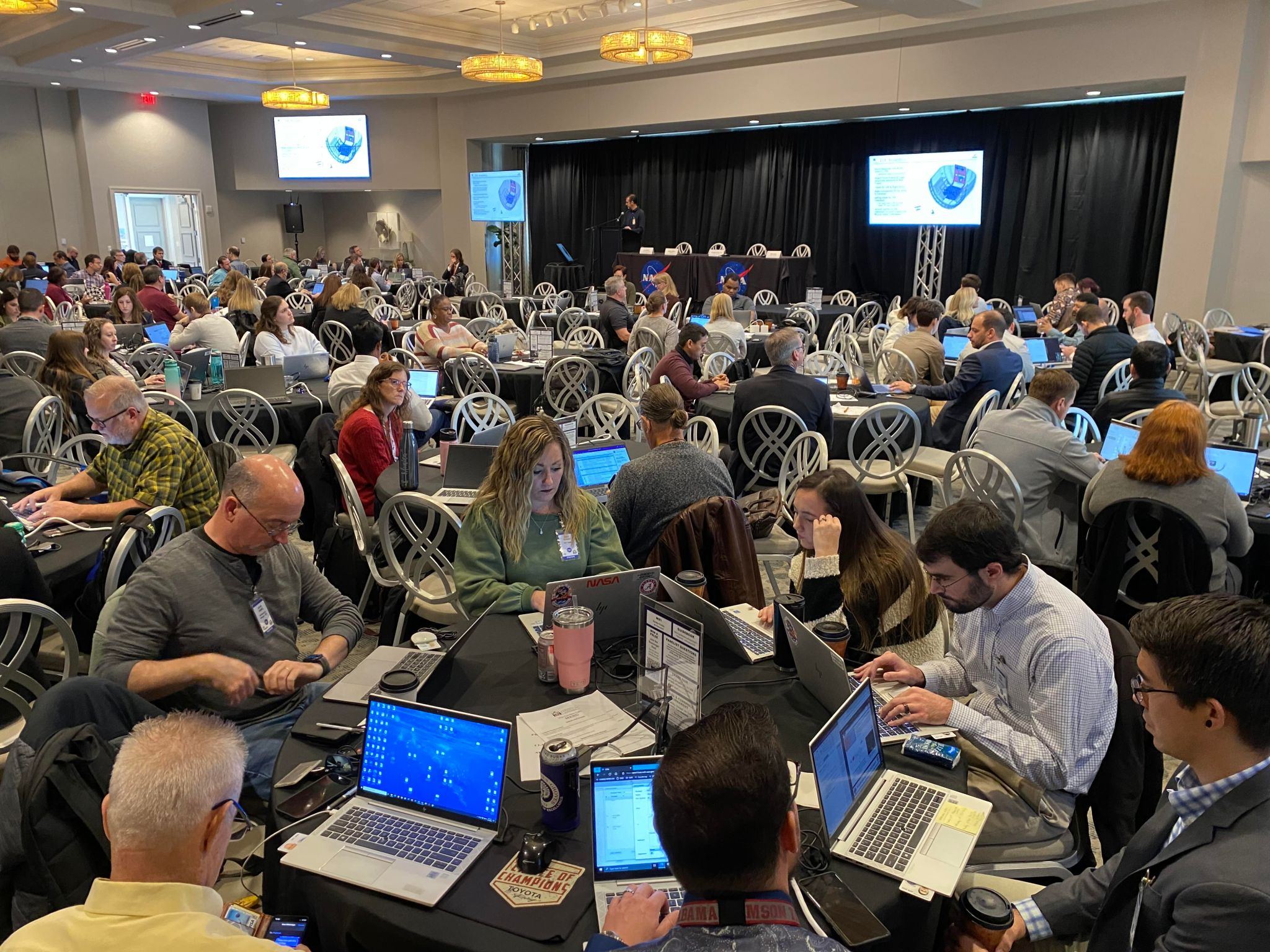
The Payload and Mission Operations Division at NASA’s Marshall Space Flight Center hosted the biannual Payload Operations Integration Working Group (POIWG) meeting Oct. 18-20 at the Huntsville Botanical Garden. The event offered payload developers, investigators, and International Space Station Program personnel the opportunity to coordinate processes and schedules and to review the status of scientific payloads currently on or soon launching to the space station. The in-person and virtual meetings drew a combined attendance of 764, which included international partners and industry professionals. The Payload Operations Integration Center at Marshall manages mission control for science on the space station. (NASA)
How Did NASA Test the Artemis Moon Rocket for Launch?
Learn more at https://www.nasa.gov/sls
#Artemis #NASA #SLS #SpaceLaunchSystem #NASASLS Credits: NASA
Artemis I is the test flight of NASA’s Space Launch System rocket and NASA’s Orion Spacecraft. Leading up to launch, testing of the rocket, systems, and teams had to be done to prepare SLS for liftoff to the Moon. Watch to learn how NASA engineers and technicians put SLS to the test before launch day. Learn more here.
Marshall Data Scientist Aaron Kaulfus Streamlines Data Discovery
(This is the sixth in a series of profiles on early career scientists in the Earth Science Branch at NASA’s Marshall Space Flight Center.)
By Dauna Coulter
“I grew up in Gatesville, Texas,” says NASA data scientist Aaron Kaulfus. “In 1997, there was a huge tornado outbreak in the area. One of the strongest tornadoes on record hit Jarrell, Texas, not far from where I lived. The atmosphere just felt weird that day. I’ll never forget it. From that day on, I was intrigued by weather. I was 7 years old.”
When Kaulfus graduated from high school, he earned a bachelor’s degree in meteorology from the University of Oklahoma, and later went on to earn a master’s and doctorate in atmospheric science from the University of Alabama in Huntsville.
Today, at age 32, Kaulfus works at NASA’s Marshall Space Flight Center in the Earth Science Branch. Part of his job is to make sure critical data needed by Earth scientists and weather researchers is readily available – easy to find and use.
“There are 12 NASA science teams interested in Earth science commercial data,” he explains. “Sometimes a principal investigator on a NASA project or mission will order the data from a particular vendor. So, we work with them to get them what they need.”
Kaulfus leads a team that develops cutting-edge, cloud-based tools for searching, discovering, archiving, and distributing commercial satellite data acquired by NASA. They also operate a data publication system that makes these data available through the cloud.
“As the data management team for the Commercial SmallSat Data Acquisition Program, we do a 1-year evaluation of the data to see if it’s useful,” Kaulfus said. “The commercial data is usually higher resolution than some of the NASA satellite data, but also not as high quality. We need good accuracy, so we evaluate it to determine if the tradeoffs are worth it. For example, if it is not highly accurate, is it useful anyway? If it’s warranted, we ingest it into our system. The goal is to get more high value data sets into the cloud and into cloud-optimized data format.”
Kaulfus collects data on the job, but in his spare time he enjoys collecting “old things.” He has assembled a collection of over 100 classic country albums. He enjoys listening to Ed Ames, Jim Reeves, George Jones, and many more of the greats. And if you visit him when he’s home in Texas, he’ll take you for a ride on the old tractor he restored.
“When my parents bought their house years ago, we looked in the barn and discovered a 1944 International Harvester tractor,” Kaulfus said. “Of course, it wouldn’t run, and it looked pretty bad. I cleaned it up and got it running. I even drive to town sometimes when I’m back home.”
His grandparents lived nearby.
“When I was growing up, I got to see them most weekends and spent a lot of time with them,” Kaulfus said. “They were farmers, and good role models who taught me the value of hard work.”
That lesson came in handy with all the physics he had to learn in college.
“I come from a small town, and my high school didn’t offer many advanced courses,” he said. “I kind of cruised through high school. College woke me up. I had to work hard.”
Kaulfus, the first in his immediate family to get an advanced degree, is very happy with his job.
“Five years ago, I never would have thought I’d end up working for NASA,” he said. “And here I am.”
Coulter, a Media Fusion employee, supports Marshall’s Office of Strategic Analysis & Communications.
NASA’s Webb Takes Star-Filled Portrait of Pillars of Creation
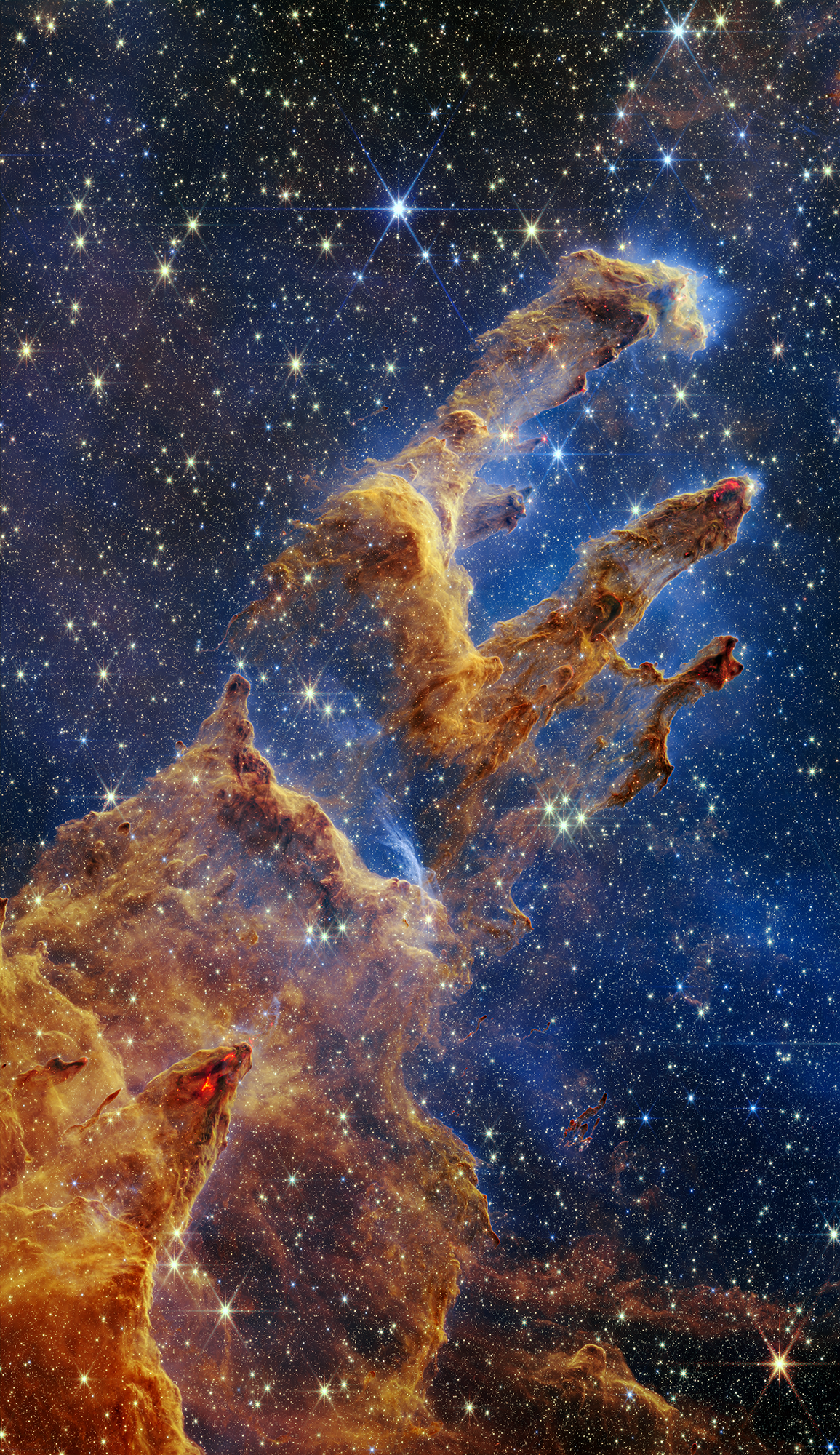
NASA’s James Webb Space Telescope has captured a lush, highly detailed landscape – the iconic Pillars of Creation – where new stars are forming within dense clouds of gas and dust. The three-dimensional pillars look like majestic rock formations, but are far more permeable. These columns are made up of cool interstellar gas and dust that appear – at times – semi-transparent in near-infrared light.
Webb’s new view of the Pillars of Creation, which were first made famous when imaged by NASA’s Hubble Space Telescope in 1995, will help researchers revamp their models of star formation by identifying far more precise counts of newly formed stars, along with the quantities of gas and dust in the region. Over time, they will begin to build a clearer understanding of how stars form and burst out of these dusty clouds over millions of years.
Newly formed stars are the scene-stealers in this image from Webb’s Near-Infrared Camera (NIRCam). These are the bright red orbs that typically have diffraction spikes and lie outside one of the dusty pillars. When knots with sufficient mass form within the pillars of gas and dust, they begin to collapse under their own gravity, slowly heat up, and eventually form new stars.
What about those wavy lines that look like lava at the edges of some pillars? These are ejections from stars that are still forming within the gas and dust. Young stars periodically shoot out supersonic jets that collide with clouds of material, like these thick pillars. This sometimes also results in bow shocks, which can form wavy patterns like a boat does as it moves through water. The crimson glow comes from the energetic hydrogen molecules that result from jets and shocks. This is evident in the second and third pillars from the top – the NIRCam image is practically pulsing with their activity. These young stars are estimated to be only a few hundred thousand years old.
Although it may appear that near-infrared light has allowed Webb to “pierce through” the clouds to reveal great cosmic distances beyond the pillars, there are no galaxies in this view. Instead, a mix of translucent gas and dust known as the interstellar medium in the densest part of our Milky Way galaxy’s disk blocks our view of the deeper universe.
This scene was first imaged by Hubble in 1995 and revisited in 2014, but many other observatories have also stared deeply at this region. Each advanced instrument offers researchers new details about this region, which is practically overflowing with stars.
This tightly cropped image is set within the vast Eagle Nebula, which lies 6,500 light-years away. Download the full-resolution, uncompressed version and supporting visuals of Webb’s near-infrared image, the comparison of Hubble and Webb’s images, and the video tour of Webb’s image from the Space Telescope Science Institute.
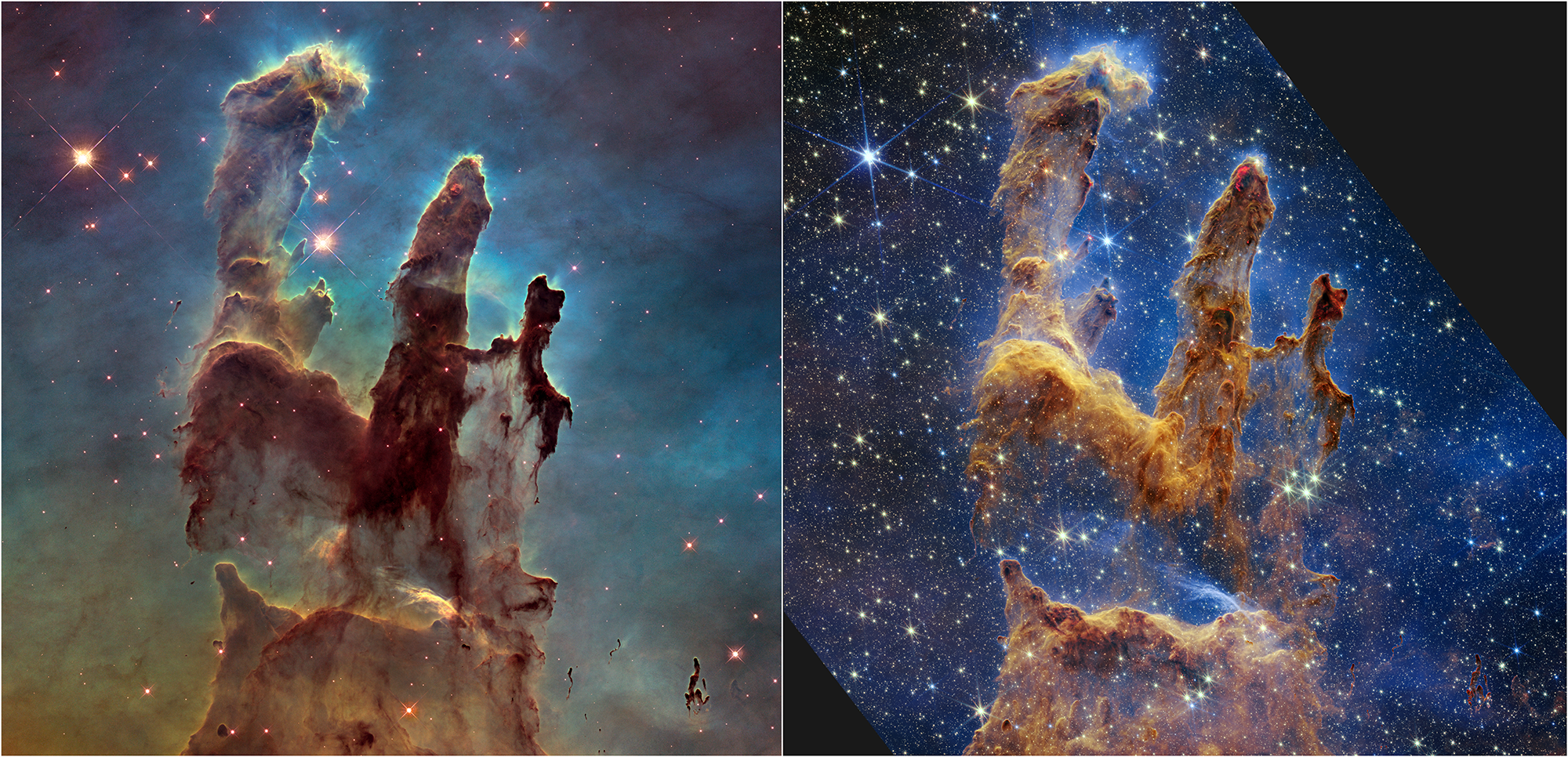
The James Webb Space Telescope is the world’s premier space science observatory. Webb will solve mysteries in our solar system, look beyond to distant worlds around other stars, and probe the mysterious structures and origins of our universe and our place in it. Webb is an international program led by NASA with its partners, ESA (European Space Agency) and CSA (Canadian Space Agency).
Powerful Neutron Star’s Behavior Surprises IXPE Researchers
In February, NASA’s Imaging X-ray Polarimetry Explorer (IXPE) observed its first accreting neutron star: Hercules X-1, more than 21,000 light-years from Earth. Now a new study based on those observations has upended traditional assumptions about neutron stars and the interior processes that drive these ultra-powerful objects.
“The findings were unexpected,” said Steve Ehlert, an astrophysicist at NASA’s Marshall Space Flight Center. “There’s a lot of surprised and excited head-scratching going on right now in regard to this neutron star.”
The study, published in the October 24 issue of the journal Nature Astronomy, is a step toward solving longstanding mysteries about these dense, spinning, undead phenomena.
Hercules X-1 isn’t alone in space. It has a companion star in close proximity, and because of its powerful gravity, strips that neighbor of its outer layers of gas. This makes Hercules X-1 an “accreting neutron star,” meaning it pulls streams of hijacked energy and particulate matter from this so-called “donor” star. The material is dragged along the neutron star’s own intense magnetic field lines, and forms an accretion disk around Hercules X-1.
Neutron stars in a binary system such as Hercules X-1 – first identified in 1971 as 4U1656+35 – are the result of massive stars that have gone supernova. The cataclysmic release of energy shrinks them dramatically, sometimes to just 10-12 miles in diameter. They remain incredibly dense, with a mass roughly one and a half or two times that of the Sun and a magnetic field trillions of times that of Earth.
Hercules X-1 is also a pulsar. Pulsars are neutron stars which rotate faster and faster as their cores collapse, emitting powerful beams of electromagnetic radiation from their poles. These energetic strobes register as “pulses,” detectable across distances of thousands of light-years by IXPE and other telescopes.
Scientists know a lot about the strength of a neutron star’s magnetic field, Ehlert noted, but have yet to fully grasp the physical structure of that field, how and why it fluctuates over time, and the relationship between accreting neutron star and its donor star.
“That’s where IXPE really shines,” said Brian Ramsey, IXPE principal investigator at Marshall. “The effects we infer from polarization are impossible to see directly, operating on scales we could never hope to capture using conventional means. IXPE is helping us document the behavior of the invisible world.”
IXPE builds on the discoveries of NASA’s Chandra X-ray Observatory and other space telescopes by measuring the polarization of X-ray light. Polarization is a property of light that tells us about the interconnected electric and magnetic fields that make up all wavelengths of light. These fields interact to create oscillation, or vibration, at right angles to the light’s path of travel. When its electric fields vibrate in a single, unified direction, we say the light is polarized.
“IXPE is a new and novel set of measurements in a complex system which helps us understand that system better than we’ve ever done before,” Ramsey added.
But with understanding comes new questions. As documented in the new paper, IXPE’s analysis of Hercules X-1 revealed some surprises. Based on scientific modeling, researchers had anticipated a 60% to 80% degree of polarization of emitted X-rays, but the data showed just 8.6% throughout the pulsar’s cycle of rotation.
“Such a large discrepancy implies that our ideas about how X-rays are generated in Hercules X-1, and possibly other pulsars, will need to be substantially revised,” said Juri Poutanen of the University of Turku, Finland, who leads IXPE research into accreting neutron stars.
The system has previously showed regular variations in brightness with a period of 35 days, despite the two stars orbiting each other every 1.7 days. Such fluctuation could indicate what is known in astrophysics as precession, an ongoing process of slow changes to a celestial body’s orbital or rotational parameters. In other words, the accretion disk could be warped or wobbling as it spins.
“It was suggested, however, that also the pulsar itself might be precessing and IXPE observations indeed indicate that this might be the case.” said Victor Doroshenko of the University of Tuebingen in Germany, the lead author of the paper.
Whatever is causing the observed variability – and whether it may be tied to low polarization of X-ray emissions – will require additional observations. Researchers will continue studying this neutron star as well as others to see if the low polarization measured at Hercules X-1 is typical or unusual.
“What excites me most is the chance to gain new understanding of the big questions IXPE can help us answer – how neutron stars and black holes fire off such high-energy particles,” Ehlert said. “That’s not an easy thing, even in such extreme space environments.”
Part of NASA’s Small Explorer mission series, IXPE launched on a Falcon 9 rocket from NASA’s Kennedy Space Center in December 2021. It now orbits 370 miles above Earth’s equator. The mission is a partnership between NASA and the Italian Space Agency, with partners and science collaborators in 13 countries. Ball Aerospace, headquartered in Broomfield, Colorado, manages spacecraft operations.


























